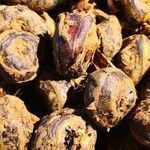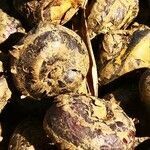A robust stoloniferous perennial with tufted culms from a contracted base. Stolons to 30 cm long and 6 mm thick with 5- long sheaths covering only the bases of the 3-8 cm long internodes. Culms 40-120 cm long and 4-8 mm thick when mature but contracted to 2-3 mm immediately below the inflorescence, rounded and hollow, transversely septate at 3-10 cm intervals; surface (at least when dry) with small irregular notches and furrows. Sheaths closed, to 1/3-1/2 the culm height, greyish to brown and ending in a triangular lobe with a narrow transparent margin and a wider dark purple border or dark dotted area inside the transparent margin; 3-4 Lateral veins joining the central vein immediately below the apex. Spikelets lanceolate-cylindric, 2.5-5.0 cm long and 2-6 mm wide, much narrower than the culm, but some culms often with the spikelet aborted, leaving only a scar, Lowest glumes scale-like but much shorter than the upper, with a wide transparent margin. Glumes 4-6 mm long, very thick and closely overlapping, pale brownish or straw-coloured; marginal border thinner and transparent; apex rounded; midrib obscure at least in mature glumes. Perianth of about 7 long and slender bristles densely set with short and recurved spine-like teeth. Stamens 3; anthers elongate, apiculate. Style with 2-3 style-branches. Nutlet smooth, about 2 mm long (excluding the long, triangular, brown appendage).
Perennials. Stolons slender, often terminated by a tuber. Culms erect, grayish green, tufted, 15-60 cm tall, 1.5-3 mm thick, cylindric, smooth, glabrous, surface with transverse septa, nodes evident when dry. Leaf sheaths 2 or 3, greenish yellow, purplish red, or brown, 2-20 cm, mouth obliquely truncate, apex acute. Spikelet pale green, cylindric, 1.5-4 cm × 6-7 mm, many flowered. Basal 2 glumes empty, amplexicaul for whole spikelet base; fertile glumes grayish green, laxly imbricate, broadly oblong to ovate-oblong, 3-5 × 2.5-3.5(-4) mm, subleathery, pale brown puncticulate and finely striate, margin pale yellow and membranous, apex obtuse. Perianth bristles 7, ca. 1.5 × as long as nutlet, retrorsely spinulose. Stigmas 3. Nutlet brown when mature, broadly obovoid, ca. 2.5 × 1.8 mm, biconvex, essentially smooth but faintly and finely cancellate with hexagonal to oblong hexagonal epidermal cells, apex not constricted but with an annular thickening; persistent style base triangular-attenuate, flattened, not spongy, base ca. 1/2 as wide as nutlet. Fl. and fr. May-Oct. 2n = 38, ca. 108.
A herb which grows in water. It is a tufted sedge with round green stems. The bases are covered with brown sheaths. The stem is about a metre high and 1 cm across. It grows 30-200 cm high. From the top of each planted corm, several slender horizontal rhizomes radiate out into the mud, each terminating in a corm. The edible part consists of a flattened corm. The rhizome is short. Under the ground there are stolons bearing tubers. The tubers are almost round and have 4-6 distinct rings. They are about 1 cm across but can be 4 cm across. They are dark brown. The stems are tufted and slender. There are fine lines along the stems. The leaves are reduced to thin tube like sheaths. These are purplish. Each plant produces these long tubular leaves that project above the water surface. The flower spike is on the end of the plant. There are many flowers. The flowers are 1.5-6 cm long by 3-6 mm wide. The fruit is a nut 1.5-2 mm long.



